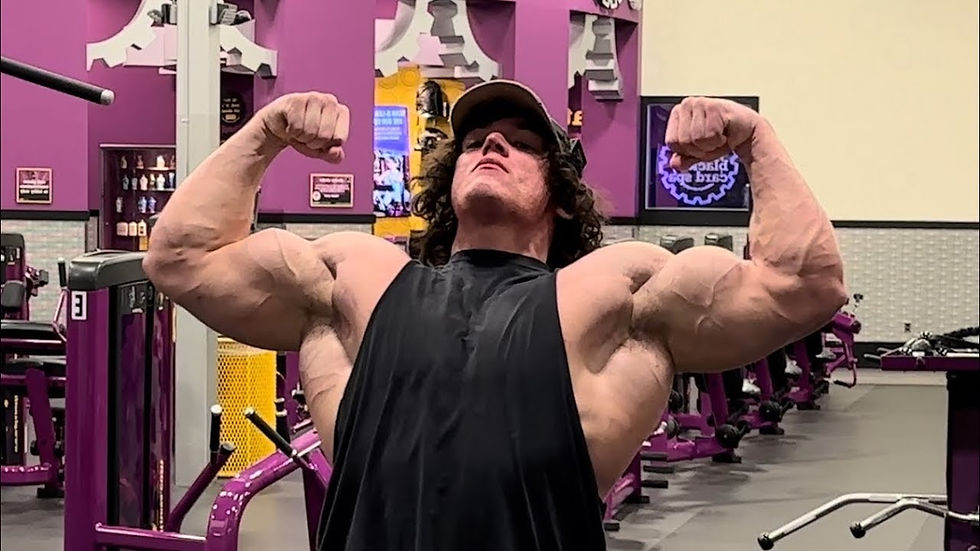(UN)NATURAL Influencers
- Coach Taj
- Jan 23
- 4 min read
Updated: 4 days ago

Today, as I was scrolling through my feed, I stumbled across a post from a fitness influencer who claimed to be “natural” but admitted to using peptides to stay lean while building muscle. Her comment section was full of people praising her, saying things like, “Wow, you’re so healthy!” and “I need to try peptides too!” Honestly, it stopped me in my tracks. It’s the perfect example of how dangerous and delusional the fitness industry has become on social media.
#1 - Let’s get one thing straight right now: SHE IS NOT natural.
Yes, peptides naturally occur in the body. They’re short chains of amino acids, and you can get small amounts from foods like eggs, fish, and meat. But the peptides that influencers use? Those are synthetic. They’re engineered in labs to mimic hormones like human growth hormone (HGH) or to stimulate its release. They’re not some harmless supplement or part of a clean diet—they’re performance-enhancing compounds designed to manipulate your body’s natural processes.
For example, peptides like CJC-1295 and ipamorelin are commonly used to stimulate HGH production. This can lead to increased muscle growth, faster recovery, and fat loss. It sounds amazing, right? But here’s the catch: peptides like these are banned in professional sports and competitions.
Organizations like the World Anti-Doping Agency (WADA) classify them as performance-enhancing drugs (PEDs) because they give users an unfair advantage. If they’re banned in sports, how can anyone honestly call them “natural”? It’s misleading at best and downright dishonest at worst.
#2 - The Bigger Issue: How Many Influencers Are Lying to Themselves (and Us)?
Now, here’s the part that really gets to me: imagine how many influencers are using substances like peptides, steroids, or SARMs but don’t even think they need to disclose it—because they’ve convinced themselves it’s “natural.” They’re injecting peptides or using other enhancements, but they still believe they’re part of the “natural” fitness world because it’s not technically steroids or because the substances mimic something the body already produces.
It’s delusional, but it’s also incredibly dangerous. These influencers post their shredded physiques on social media, preach about clean eating and hard work, and slap the “natural” label on themselves. Their audiences—many of whom are new to fitness or simply uninformed—see this and think, “If they can do it naturally, so can I.” The reality is that their results aren’t coming from just diet and exercise, but that part gets conveniently left out.
The influencer I scrolled past at least admitted to using peptides, even if she twisted the definition of “natural” to fit her narrative. But think about how many influencers out there are using enhancements and not saying a word. Some might even fully believe they’re still natural because they’ve redefined what “natural” means in their heads.
This creates a toxic cycle where unrealistic body standards are presented as achievable with enough hard work and dedication. People compare themselves to these influencers, thinking they’re falling short when, in reality, they don’t know what’s going on behind the scenes.
#3 - Peptides Aren’t Harmless
Let’s not sugarcoat this—peptides are far from harmless. While they can sound appealing, these synthetic substances haven’t been studied long enough to fully understand their long-term effects. What we do know is that they can cause side effects like joint pain, swelling, and even disruption of your body’s natural hormone production.
The bigger issue is that influencers rarely talk about these risks. Instead, they act like peptides are just another part of a “healthy lifestyle”—as harmless as taking vitamins or eating a salad. But these substances aren’t just another wellness hack. They’re powerful compounds designed to manipulate your body’s natural processes, and they come with very real risks.
#4 - Social Media Is Twisting Reality
This whole situation is a reflection of a larger problem in the fitness industry: the way social media distorts our perception of health and fitness. Platforms like Instagram and TikTok are full of influencers promoting impossible standards, whether it’s through filters, editing, or substances like peptides.
When someone with a massive following casually admits to using peptides but still calls themselves natural, it sends a dangerous message. It normalizes the idea that enhancements like this are not only okay but necessary to look a certain way. And worse, it makes people feel like they have to resort to these measures just to keep up.
But here’s the truth: fitness isn’t about shortcuts, hacks, or substances. Real, sustainable progress takes time, effort, and patience. It’s about building healthy habits, staying consistent, and working with what your body can naturally achieve. Peptides, steroids, or any other enhancement might seem like a quick fix, but they come with risks—and they’re not natural, no matter what anyone tries to tell you.
Final Thoughts
If there’s one thing I want you to take away from this, it’s this: be critical of what you see online. Social media is a highlight reel, and influencers aren’t always transparent about what they’re doing behind the scenes. That shredded “natural” body you’re comparing yourself to might not be natural at all.
And that’s okay—it’s not about tearing anyone down. It’s about recognizing the difference between reality and what’s being sold to us. Don’t let someone else’s shortcuts or unrealistic standards make you feel like you’re not doing enough.
Your fitness journey is yours. Focus on progress, consistency, and building habits that will serve you for life. Because at the end of the day, real success doesn’t come from a vial of peptides or any other enhancement—it comes from putting in the work, being patient, and staying true to yourself.

Comments